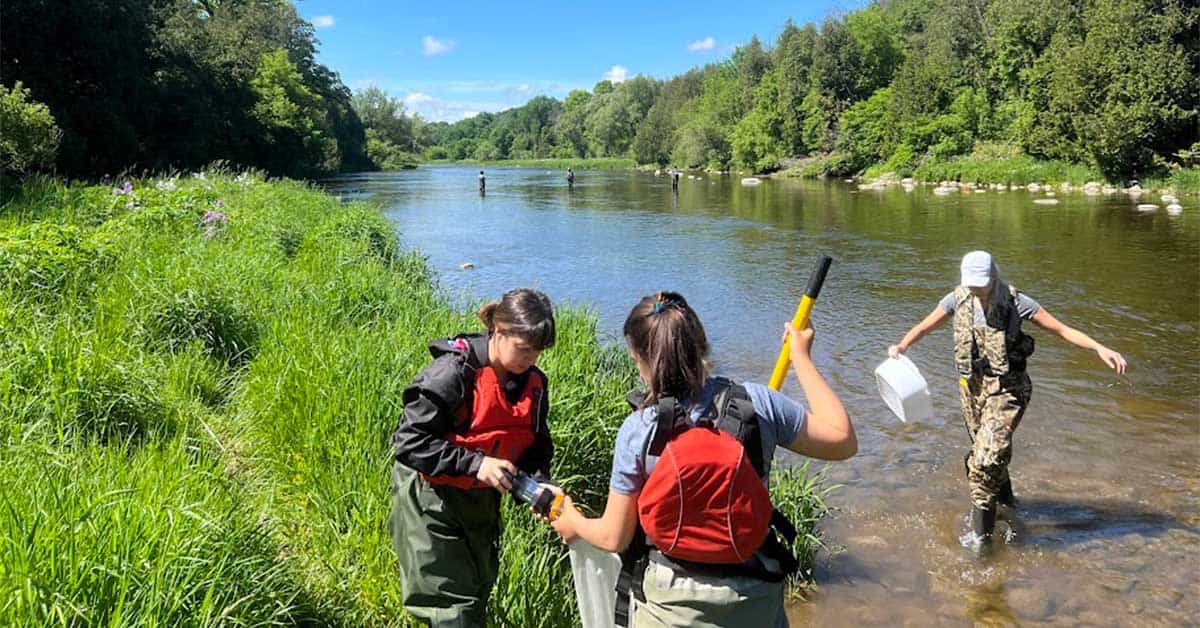The Friends of the Grand River have teamed up with the University of Guelph to begin what they hope will be a years’ long process to thoroughly study the Grand and get to the bottom of its health problems.
For about four or five years now, members of Friends of the Grand River, a group of volunteers who work to protect and promote the waterway, and primarily its trout fishery, have noticed that the annually stocked trout in the river are not surviving past their first year. The trout fishery is not thriving and they are trying to find out why.
To this end, last year they launched two studies simultaneously: one to understand the socio-economic importance of the Grand River for the Fergus and Elora communities in terms of how much of the economy depends on the river each year, and another study to understand what is going on with the river’s biology and ecology, mainly to understand why the trout aren’t surviving.
Last summer, Prof. Ryan Prosser from the School of Environmental Sciences at the University of Guelph took on the project and launched the study. He and his team began by looking at the levels of benthic biodiversity, that is the diversity and quantity of insect life present in the river. Insects are sensitive to water quality, some species more than others, and the presence or lack of benthic biodiversity indicates the river’s health. Insects are also at the foundation of the river’s food chain, since the trout rely on them as a main food source.
Last month, Prosser presented his preliminary findings about benthic biodiversity in the Grand to the Friends of the Grand River. His team took samples at 18 sites between the Shand Dam and West Montrose.
Generally, Prosser and his team found that biodiversity was lower closer to the dam, and grew higher downstream from it. The highest biodiversity was found in the Elora Conservation Area, and upstream from West Montrose. The worst section was near the Pierpoint area in Fergus.
Prosser took his findings about which insect species were present at each of the sites, and reported them as a biotic index, where higher numbers represent less biodiversity. The biotic index numbers closest to the dam were some of the highest, ranging between 6.2 and 6.5. Prosser says a river is considered healthy when it is in the range between four and the low five’s.
“The higher the number, the poorer the quality, or the more insensitive the community,” said Prosser during his presentation. “So the trend that we’re seeing from the sampling in August – and you could tell this just by looking at the samples we were taking out – up by the dam and downstream from the dam is not great. You can see the biotic index, you get these large numbers, and then as you go downstream you’re starting to see taxa that are more sensitive to changes in water quality.
“And it was obvious. The first couple ripples downstream of the dam are dominated by isopods and this group of trichoptera called hydropsychidae. So these are common in areas that are impacted by nutrient pollution. So that was pretty obvious. You’re picking up rocks and you’re not seeing those perlidae, those stoneflies (which are a more sensitive species),” he said.
Water from Belwood Lake is released to the Grand River from the bottom of the Shand Dam. This provides cold water that cools down the river and makes the trout fishery possible, since the trout species present generally rely on colder water temperatures to survive.
“There’s obviously some sort of environmental issue, I would say, in that upper stretch,” said Rob Voisin, the chair of the board for Friends of the Grand River. “Because the water itself should be the coldest of the entire river and there’s lots of good water to be producing a healthy bug population.
“That, I think, is the eye-opening piece, is the fact that it’s the worst water in terms of the survival rate for some of these more sensitive insects suggests that there’s something water quality-wise or environmental-wise that we’ve got to get to the bottom of here.”
Voisin noted that anglers noticed better survival rates for trout this year than the last few years during the pandemic, “So hopefully we’re trending in the right direction,” he said.
Besides looking at benthic biodiversity, Prosser and his team also set up studies to learn about the presence of pesticides, the salinity of the river and the possibility of toxic algal blooms in Belwood Lake. He is also working on accessing long-term data about the river’s temperature and in depth data from a former benthic biodiversity study conducted 20 years ago. Anglers have also noticed a lot of geese on the river, and are hoping he will consider this as well.
The salinity study results will come in over the winter, and next summer Prosser plans to measure biodiversity even more, along with continuing the other studies he started.
So far, the University of Guelph has covered the laboratory costs for the study, but Voisin says as the study continues, fundraising will be needed to cover these costs.
“Hopefully the river is important to everybody that lives in these communities and accesses these communities. And, in the climate change era, healthy water is something that should be a priority that’s on everybody’s mind for our generation and future generations. So getting involved either with volunteer hours or donations would be an amazing way to ensure we keep getting to the bottom of our health of the Grand River.”
To find out more, Voisin says people can go to www.friendsofthegrandriver.com.









